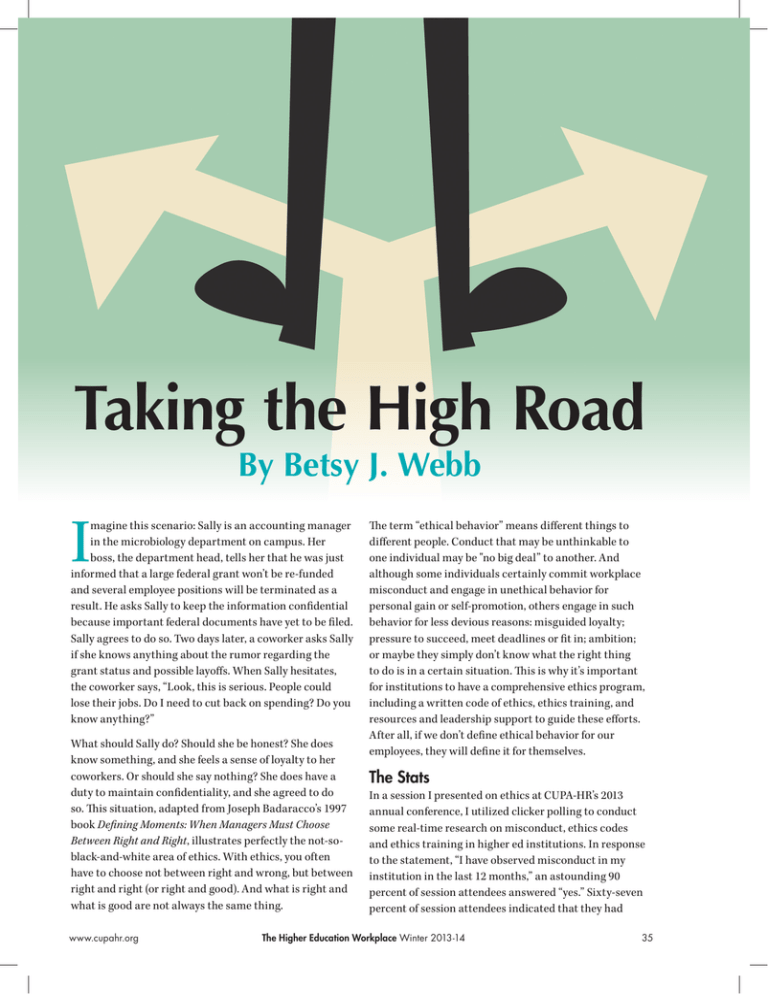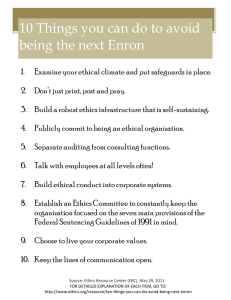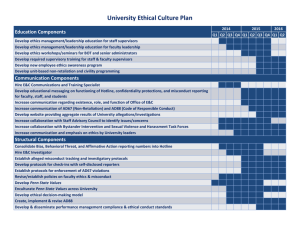Taking the High Road I By Betsy J. Webb
advertisement

Taking the High Road By Betsy J. Webb I magine this scenario: Sally is an accounting manager in the microbiology department on campus. Her boss, the department head, tells her that he was just informed that a large federal grant won’t be re-funded and several employee positions will be terminated as a result. He asks Sally to keep the information confidential because important federal documents have yet to be filed. Sally agrees to do so. Two days later, a coworker asks Sally if she knows anything about the rumor regarding the grant status and possible layoffs. When Sally hesitates, the coworker says, “Look, this is serious. People could lose their jobs. Do I need to cut back on spending? Do you know anything?” What should Sally do? Should she be honest? She does know something, and she feels a sense of loyalty to her coworkers. Or should she say nothing? She does have a duty to maintain confidentiality, and she agreed to do so. This situation, adapted from Joseph Badaracco’s 1997 book Defining Moments: When Managers Must Choose Between Right and Right, illustrates perfectly the not-soblack-and-white area of ethics. With ethics, you often have to choose not between right and wrong, but between right and right (or right and good). And what is right and what is good are not always the same thing. www.cupahr.org The term “ethical behavior” means different things to different people. Conduct that may be unthinkable to one individual may be "no big deal” to another. And although some individuals certainly commit workplace misconduct and engage in unethical behavior for personal gain or self-promotion, others engage in such behavior for less devious reasons: misguided loyalty; pressure to succeed, meet deadlines or fit in; ambition; or maybe they simply don’t know what the right thing to do is in a certain situation. This is why it’s important for institutions to have a comprehensive ethics program, including a written code of ethics, ethics training, and resources and leadership support to guide these efforts. After all, if we don’t define ethical behavior for our employees, they will define it for themselves. The Stats In a session I presented on ethics at CUPA-HR’s 2013 annual conference, I utilized clicker polling to conduct some real-time research on misconduct, ethics codes and ethics training in higher ed institutions. In response to the statement, “I have observed misconduct in my institution in the last 12 months,” an astounding 90 percent of session attendees answered “yes.” Sixty-seven percent of session attendees indicated that they had The Higher Education Workplace Winter 2013-14 35 reported the misconduct. And 36 percent said that they had felt pressure from others to commit workplace misconduct. Nationally, according to 2012 statistics from the Ethics Resource Center, 45 percent of U.S. workers have observed misconduct on the job; 65 percent reported the misconduct; and 13 percent felt pressure to commit misconduct. As for ethics codes, half of the conference session attendees indicated that their institution has a written code of ethics, 41 percent said that their situations and make clear from the institution’s standpoint what does and does not constitute acceptable behavior. Components of an Ethics Program Most higher education institutions (especially public institutions that fall under the jurisdiction of state government) do have a code of ethics, but in many cases, the language is buried in the pages of an employee handbook or state statute. Even if your institution has a written code of ethics, just having words on paper isn’t enough. A code of ethics must be accompanied by ethics training, resources to promote an ethical environment and strong leadership support. “Ethical behavior” means different things to different people. Conduct that may be unthinkable to one individual may be no big deal to another. institution does not, and 9 percent were unsure. Of those who indicated that their institution does have a written code of ethics, only 29 percent said that employees get a copy at the moment of hire. And 67 percent said that they do not conduct ethics training at their institution. What Is Misconduct? Consider the following scenarios: 1. An employee uses a company copier to make a few personal copies. 2. A staff member does some “exploring” on a university computer to find out where another employee lives. 3. A non-exempt employee has not completed her expected work hours. She misreports her hours, just for one pay period, with the intent of making up the time during the next pay period. 4. An employee shares confidential background check information on a new employee with a friend who is not associated with the new employee and does not know him in any way. Is any one of these behaviors more egregious than another? That depends on who you ask. Misconduct comes in many forms. From the scenarios listed above, to abusive behavior, to putting one’s own interests ahead of the organization’s, to Internet abuse, lying and improper hiring practices ... “misconduct” is in the eye of the beholder. While we cannot reset an individual’s moral compass, we can provide that individual with the skill sets and resources needed to think through questionable 36 Code of Ethics A code of ethics, sometimes also referred to as a code of conduct, defines the values of an organization, sets the tone for expected behavior, promotes dialogue for the gray areas, and provides guidance to decision makers in tough situations. Having a written code of ethics may decrease retaliation when misconduct is reported and may protect the organization when misconduct occurs. A written code of ethics typically contains language on conflicts of interest, self-dealing, unwarranted privileges, gifts, nepotism, whistle-blowing, use of college resources or property, confidentiality, political activity and more. Also contained within a code of ethics are guidelines on how to report a violation. If you’re looking to create a code of ethics for your institution, the Ethics Resource Center (www.ethics.org) has several resources that can help you get started. You can also see examples of higher ed ethics codes in CUPA-HR’s Knowledge Center (www.cupahr.org/ knowledgecenter/ethics). Ethics Training With all the mandated training human resources must do, ethics training often falls off the radar and more often than not only comes as a result of something bad happening. However, if we can be more proactive in outlining the expectations of employees up front, we may not have to deal with the repercussions on the back end of someone making an ethical misstep. But teaching to a code tends to be pretty boring, and people can tune out pretty quickly. Thus, ethics training should be interactive, with real-life scenarios relative to real work situations. It should be cross-functional and customized to the audience. It should provide for The Higher Education Workplace Winter 2013-14 www.cupahr.org discussion and dialogue around the issues and the gray areas (of which there are plenty in most misconduct scenarios). See the sidebar on page 37 for a few sample scenarios I’ve used in my training. After I’ve described the scenario and allowed time for discussion, I refer to the part of the institutional ethics code that applies to that particular situation. If you have the appropriate technology, using clicker polling can be a great way to encourage participation and provides for anonymity in the answers. You can also utilize text message polling technology (there are several websites that offer this application free of charge). I’ve also used the “red light, green light” game in my training Sample Scenarios for Ethics Training Scenario #1: The chemistry department has contacted you in HR for assistance with a pay increase. They have a stellar employee who they want to retain. They want your help rewording the job duties for the position, although they haven’t really changed. The department knows they need this on paper to justify the increase. What would you do? Would this ever be OK? If yes, under what circumstances? Scenario #2: You just received an e-mail on your work computer at the university. You’ve been added to an e-mail stream inviting you to join in a playful minorstakes betting pool on the college football teams playing each week. The e-mail provides instructions on how to join and states that bets for this week are due by 5:00 p.m. today. Winners will be announced via e-mail on Tuesday morning. Would you participate? Why or why not? What are the possible ramifications to the institution and the individuals participating? Scenario #3: Before working for the university, you were employed by a public agency in the same state. You have just become aware that a former colleague, who has a history of mental illness, is applying for a position within the university. A member of the search committee informs you that your former colleague has made it to the list of final candidates. From previous experience, you know that her attendance is spotty, she causes a lot of drama in the office, and she is unreliable when she does not take her medication. She has not listed you as a reference for this position. Do you bring up your concerns to the search committee member? Is there a way to do so ethically and/or legally, without disclosing her mental illness? www.cupahr.org — red means “Stop! This is not ethical behavior!” and green means “Go! It’s OK, this is not an ethical issue.” In this activity, I’ll ask participants to stand in a circle as I describe an ethics-related scenario. If they deem the scenario a red light, they stand still; if they deem it a green-light scenario, they take a few steps forward — just like the child’s game. A quick Google search yields many more ethics training activities that can be customized to your organizational setting. Ethics Resources and Leadership Support There are several ways that an institution can demonstrate its commitment to creating and maintaining an ethical culture. A few institutions have independent ethics commissions (or use their state government’s ethics commissions) to hear and investigate complaints of misconduct. Some institutions have an ethics officer on staff. Some have an ethics hotline or website where employees can anonymously report misconduct. Your university’s legal counsel and ombudsperson can be good resources, as well. Institutions can also integrate ethics into the hiring process by asking questions related to ethical beliefs in interviews and into the performance management process by evaluating employees on their ability to make ethical decisions. As with any institution-wide initiative, leadership support is critical. Institutional leaders must take ethics seriously, must initiate discussion and must model ethical behavior in every situation. A Better Workplace Research has shown that organizations with strong ethical values — from top leadership to middle managers to frontline workers — experience less misconduct, more frequent reporting of misbehavior and less retaliation. Having a comprehensive ethics program, and ensuring that every employee is made aware of and properly trained on the resources available, can protect an institution and its employees from unnecessary media scrutiny, investigations and litigation and can help create a climate of trust, respect and integrity. As Benjamin Franklin so aptly put it, “It takes many good deeds to build a good reputation, and only one bad one to lose it.” Do your employees know the good from the bad? Betsy J. Webb, SPHR, is professional development and training manager at Montana State University. She can be reached at elizabeth.webb@montana.edu. The Higher Education Workplace Winter 2013-14 37




